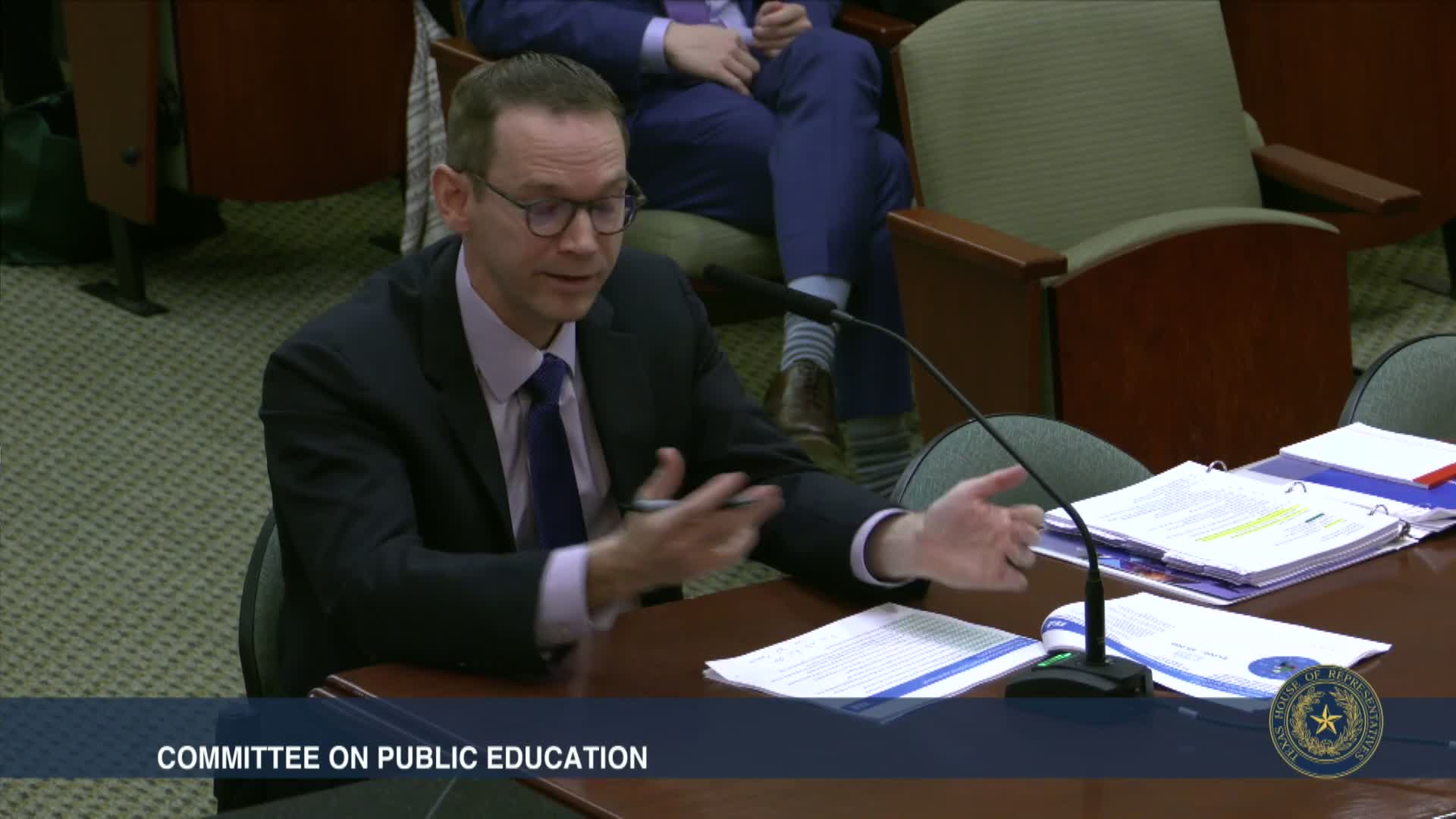TEA tells legislators Texas districts face roughly $1.7 billion annual special‑education shortfall
February 25, 2025 | Committee on Public Education, HOUSE OF REPRESENTATIVES, Legislative, Texas
This article was created by AI summarizing key points discussed. AI makes mistakes, so for full details and context, please refer to the video of the full meeting. Please report any errors so we can fix them. Report an error »

Texas Education Agency Commissioner Mike Morath told the House Committee on Public Education that the state’s public school districts spend far more on special education services than the state and federal funding earmarked specifically for those services, creating an ongoing structural shortfall.
Morath said the shortfall was about $1.2 billion per year in 2017 and has grown, in the most recent audited accounting, to roughly $1.7 billion annually. The agency’s analysis aggregates district audited financial statements and compares dedicated special‑education revenues (state SPED formulas, federal IDEA, SHARS reimbursement) with district‑reported SPED expenditures.
Why it matters
Morath warned the shortfall forces districts to cover SPED costs from general education resources (M&O funds), which reduces the money available for classroom instruction. Several members told the commissioner they hear local frustration about increasing special‑education representation and uneven burdens across districts.
Key details
- Growth in identification: Morath said special‑education identification rose from about 8.5% a decade ago to roughly 14% in the most recent year (and has continued to climb), driven in part by improved “child find” practices and regulatory attention.
- Funding versus spending: Morath explained the blue bars in his presentation show dedicated SPED revenues; the gold bars show actual SPED expenditures that districts report. Even with rising revenue, expenditures rose faster, creating the deficit.
- Evaluation costs: Morath said a formal special‑education evaluation typically costs between $1,000 and $5,000 per student. Under current practice districts must perform those evaluations (including for private school students) but receive no dedicated state funding to cover the costs.
Lawmakers’ questions and requests
Rep. Hinojosa described an experience in which a child in her district waited a year for an evaluation and a family paid roughly $2,000 out of pocket; she asked for data on disparities across districts. Members requested district‑level SPED deficit data; Morath said larger districts tend to show larger deficits in absolute and relative terms and promised to provide the committee more granular analyses.
Policy implications
Morath said the 2021 Special Education Finance Commission recommended formula changes to better align funding with the different cost profiles of students — for example, distinguishing students who require intensive one‑on‑one supports from those receiving less costly services. He described the commission’s proposal to create dedicated funding for evaluations as “logical” and noted the larger system question is whether to change formulas, to add dollars, or both.
Ending
Members asked TEA for more district‑level breakdowns of the SPED deficit, the number and cost of required evaluations, and analysis of how proposed formula changes would affect districts of different sizes. Morath recommended the committee consider reforms that better match revenue to the range of SPED service costs.
Morath said the shortfall was about $1.2 billion per year in 2017 and has grown, in the most recent audited accounting, to roughly $1.7 billion annually. The agency’s analysis aggregates district audited financial statements and compares dedicated special‑education revenues (state SPED formulas, federal IDEA, SHARS reimbursement) with district‑reported SPED expenditures.
Why it matters
Morath warned the shortfall forces districts to cover SPED costs from general education resources (M&O funds), which reduces the money available for classroom instruction. Several members told the commissioner they hear local frustration about increasing special‑education representation and uneven burdens across districts.
Key details
- Growth in identification: Morath said special‑education identification rose from about 8.5% a decade ago to roughly 14% in the most recent year (and has continued to climb), driven in part by improved “child find” practices and regulatory attention.
- Funding versus spending: Morath explained the blue bars in his presentation show dedicated SPED revenues; the gold bars show actual SPED expenditures that districts report. Even with rising revenue, expenditures rose faster, creating the deficit.
- Evaluation costs: Morath said a formal special‑education evaluation typically costs between $1,000 and $5,000 per student. Under current practice districts must perform those evaluations (including for private school students) but receive no dedicated state funding to cover the costs.
Lawmakers’ questions and requests
Rep. Hinojosa described an experience in which a child in her district waited a year for an evaluation and a family paid roughly $2,000 out of pocket; she asked for data on disparities across districts. Members requested district‑level SPED deficit data; Morath said larger districts tend to show larger deficits in absolute and relative terms and promised to provide the committee more granular analyses.
Policy implications
Morath said the 2021 Special Education Finance Commission recommended formula changes to better align funding with the different cost profiles of students — for example, distinguishing students who require intensive one‑on‑one supports from those receiving less costly services. He described the commission’s proposal to create dedicated funding for evaluations as “logical” and noted the larger system question is whether to change formulas, to add dollars, or both.
Ending
Members asked TEA for more district‑level breakdowns of the SPED deficit, the number and cost of required evaluations, and analysis of how proposed formula changes would affect districts of different sizes. Morath recommended the committee consider reforms that better match revenue to the range of SPED service costs.
View full meeting
This article is based on a recent meeting—watch the full video and explore the complete transcript for deeper insights into the discussion.
View full meeting
